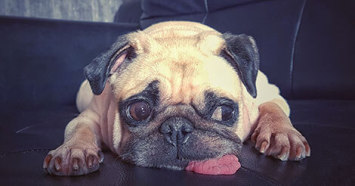
The smell of urine is not one’s choice aroma when someone walks into your home. Many pet owners face the daily struggle of pets who urinate in their home. Identifying the problem is key to prevention. The ideal approach to managing these aromas is to prevent them. But you can’t get there until you identify the root of the problem. Determining which one (or more) of the above issues is at play is crucial to solving the problem and getting urine smells gone forever.
Step One: Identify the Spots
No one needs to be told that his or her pet is urinating inside the house. Urine spots are easily identified after all. Or are they? Using your nose is not always as effective as you might think. Especially if more than one pet is urinating. Which is why purchasing a simple black light (often available at pet stores in small, handheld versions) can help. Urine will glow under a black light, making shorter, easier work of your bodily fluid ID detail. (Trust me, this is SO helpful!)
Not only is accurate identification useful for helping you clean up (more on that up next) but it’ll help your veterinarian whittle down the possible causes of the problem. (Really!) So you really, really do want to take that extra step to find the spots. Placing an X with masking tape over a whole week of time can be especially helpful when it comes to establishing a pattern for both cleaning and diagnostic purposes.
Step Two: Recognize Why Your Pet is Urinating
There are many reasons your pet could be peeing in your house. Marking with urine (to announce their presence, beckon others, establish dominance, and define their territory) is just one of the reasons why dogs and cats treat us to their innate aromas. Inappropriate urine elimination also happens for a variety of reasons. Consider the following:
Anxiety may provoke a behavior that’s often classified as an alternative version of urine marking. Cats, in particular, seem to exhibit this behavior.
Incomplete housebreaking is a common scenario, especially among young dogs but also among plenty of mature pets, many of whose owners have given up on the problem.
Dementia and other illnesses can result in inappropriate urine elimination. Blood in dog urine, along with other medical conditions, should be evaluated by your veterinarian.
Step Three: Clean Up
Scent elimination is your next step. It’s absolutely crucial (note the emphasis here) to remove the scent of previous urine marks with a good cleaner. Camouflaging the odor with another scent is not effective. Dogs and cats are, after all, far more sensitive to these scents than we are, biologically attuned to them as they are. Covering them merely makes us feel better. It does nothing for our pets’ detection of them. And if you don’t eliminate the smell you will not eliminate the behavior!
Here’s the thing: Pets who still smell urine will almost always re-mark or revisit their spots and eliminate there again. Other pets in the household may as well. Even pets who would ordinarily never pee in the home may start to consider the entire house a de facto toilet. And that makes identification of the inciting pet’s pattern that much more complicated (and concerted clean-up even more of a nightmare).
Specific Urine-eliminating Products
There are as many products out there as there are types of pets who eliminate indoors. Which is to say, it seems like an endless stream of urine-specific products are always hitting the marketplace. Here’s a smattering of the types of products out there:
Cover-uppers: Using anything with perfumes risks failing to do anything but cover the scent up. And, as I explained above, that’s not likely to solve your problem, even temporarily.
Enzymatic cleaners: I used to say that an enzymatic cleaner (those that break down the odor-causing proteins) would help neutralize the scent best to prevent recurrences of the behavior. Unfortunately, I’ve learned that they’re not always best for all spots. At least not when used alone.
Deep cleansers:
Depending on the surface, some cleansers work better. After all, you have to get the liquid off the fibers of carpets, sofas, and drapes, for example.
Ammonia eliminators:
These will help get rid of this specific element of the urine aroma. In my experience it helps the humans more than the pets, but it’s nonetheless true that if you can’t smell the ammonia they usually can’t smell as much of the rest of the urine’s components either.
Citrus, lavender and pheromone-scented products:
These can help but remember, they’re still cover-ups. You ultimately want to get at the source of the smell.
Rotating these products and giving them each time to sink into the surface (especially for the enzymatic cleaners) has been my go to approach. I’ve used them all to varying degrees of efficacy, which is why I now insist on using them all.
Step Four: When the Other Steps Don’t Cut It
Sometimes more aggressive options are in order and you have to get tough with odor control. Here are some solutions:
Deeper cleaning may be necessary for grout, tile, and other surfaces. A professional cleaning crew may be your best bet in these cases. I’ve found that power cleaning with water, followed with a house-wide soak in enzymatic cleaner helps tremendously.
Take your drapes and area rugs in for a dry cleaning. Make sure to let them know they’ve been urinated on. They often have tricks up their sleeve for situations like these.
Sad to say but sometimes getting rid of the urinated-on item is the best approach. A well-soiled sofa, for example, may not even be reupholstered without retaining the aroma.
Again, never fail to talk to your veterinarian. Not only might she or he help you solve the underlying problem, veterinarians and their team members are usually an excellent source of basic cleaning advice.